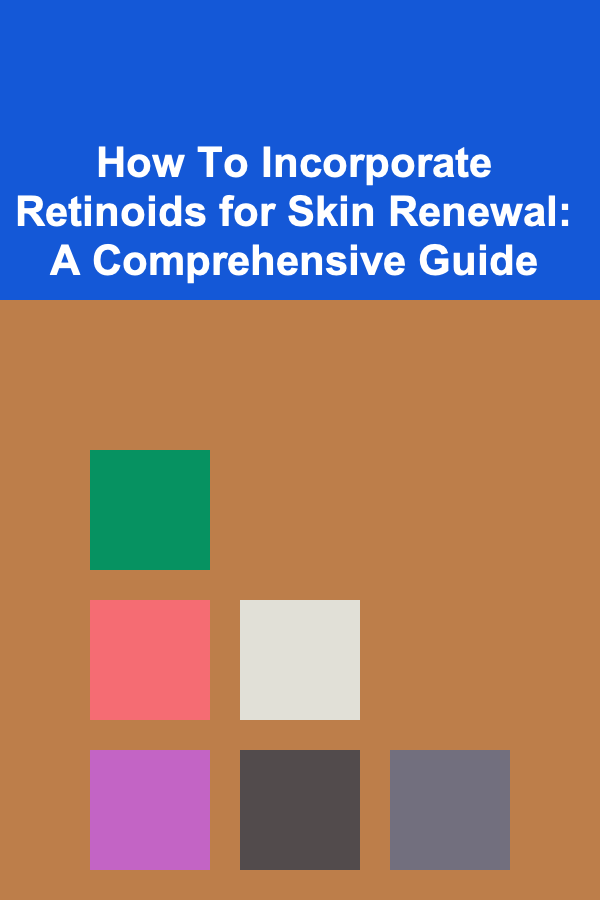
How To Incorporate Retinoids for Skin Renewal: A Comprehensive Guide
ebook include PDF & Audio bundle (Micro Guide)
$12.99$10.99
Limited Time Offer! Order within the next:

Introduction: The Power of Retinoids
Retinoids are a class of chemical compounds that are derivatives of vitamin A. They are widely recognized as one of the most effective ingredients in skincare for promoting skin renewal, combating signs of aging, treating acne, and improving overall skin health. Their ability to stimulate collagen production, accelerate cell turnover, and unclog pores makes them a powerhouse in any well-rounded skincare routine. However, due to their potency, understanding how to properly incorporate retinoids into your skincare regimen is crucial to avoid irritation and maximize their benefits. This comprehensive guide will walk you through everything you need to know, from understanding the different types of retinoids to building a personalized routine that suits your skin type and goals.
Understanding the Different Types of Retinoids
The term "retinoid" encompasses a spectrum of vitamin A derivatives, each with varying degrees of potency and accessibility. Understanding these differences is essential for choosing the right product for your skin and tolerance level.
Prescription-Strength Retinoids: The Heavy Hitters
- Tretinoin (Retinoic Acid): This is the gold standard of retinoids and requires a prescription. It's the most potent form and works directly on the skin's retinoic acid receptors without needing to be converted. Tretinoin is highly effective for treating acne, reducing wrinkles, and improving skin texture. However, it's also known for causing significant irritation, dryness, and peeling, especially during the initial adjustment period (often referred to as the "retinization" process). Different formulations exist (cream, gel, micro gel) that can affect the absorption rate and potential for irritation.
- Tazarotene: Another prescription retinoid, Tazarotene, is often considered even stronger than tretinoin. It's used for treating psoriasis, acne, and photoaging. Due to its potency, it's often reserved for those with more severe skin conditions and those who have already built up a tolerance to other retinoids. Expect a potentially longer and more intense retinization period.
- Adapalene (Differin): While originally a prescription medication, Adapalene is now available over-the-counter (OTC) at a lower concentration (0.1%). It's primarily used to treat acne but can also offer anti-aging benefits. Adapalene is generally considered less irritating than tretinoin, making it a good starting point for some individuals. Prescription strength Adapalene (0.3%) is also available for more severe cases.
Over-the-Counter Retinoids: Gentler Options
- Retinol: The most common OTC retinoid, retinol, is converted into retinoic acid by enzymes in the skin. This conversion process makes it less potent than prescription retinoids, resulting in less irritation. However, retinol still offers significant benefits with consistent use, including improved skin texture, reduced fine lines, and a brighter complexion. The effectiveness of retinol depends on its concentration and the quality of the formulation.
- Retinaldehyde (Retinal): Retinaldehyde is one step closer to retinoic acid than retinol, meaning it requires only one conversion step. This makes it more potent than retinol but generally less irritating than prescription-strength options. It's a good middle ground for those who find retinol too weak but are hesitant to use tretinoin. Retinaldehyde also possesses some direct antibacterial properties, making it beneficial for acne-prone skin.
- Retinyl Esters (Retinyl Palmitate, Retinyl Acetate): These are the weakest form of retinoids. They require multiple conversion steps to become retinoic acid, making them the least irritating but also the least effective. They are often used in skincare products for their antioxidant properties and can provide some mild benefits, but they are unlikely to deliver dramatic results.
Preparing Your Skin: Building a Solid Foundation
Before introducing a retinoid into your routine, it's crucial to ensure your skin is healthy and properly hydrated. A compromised skin barrier can exacerbate irritation and sensitivity. Focus on gentle cleansing, hydration, and sun protection for at least two weeks prior to starting a retinoid.
- Gentle Cleansing: Use a mild, non-foaming cleanser that won't strip your skin of its natural oils. Avoid harsh scrubs or cleansers containing sulfates. Look for ingredients like ceramides, glycerin, or hyaluronic acid.
- Hydration: Hydration is key! Incorporate a hydrating serum and moisturizer into your routine. Look for ingredients like hyaluronic acid, glycerin, ceramides, and squalane. Apply your moisturizer while your skin is still damp to lock in moisture.
- Sun Protection: Retinoids make your skin more sensitive to the sun, so daily sunscreen use is non-negotiable. Choose a broad-spectrum sunscreen with an SPF of 30 or higher. Reapply every two hours, especially when exposed to direct sunlight. Physical sunscreens (containing zinc oxide or titanium dioxide) are often recommended for sensitive skin.
The Gradual Incorporation Method: "Start Low and Go Slow"
The key to successful retinoid use is to introduce it gradually to allow your skin to adjust. The "start low and go slow" approach minimizes irritation and maximizes long-term benefits.
- Choose Your Retinoid: Based on your skin type, concerns, and tolerance level, select an appropriate retinoid. If you have sensitive skin or are new to retinoids, start with a low-concentration retinol or retinaldehyde. If you have more resilient skin and are looking for more dramatic results, you might consider a prescription retinoid under the guidance of a dermatologist.
- Frequency: Begin by applying the retinoid only once or twice a week. This allows your skin to acclimate to the ingredient.
- Application Technique: Apply a pea-sized amount of the retinoid to your entire face, avoiding the delicate eye area, corners of the nose, and corners of the mouth. These areas are more prone to irritation. Some people prefer to apply retinoids after moisturizing (the "sandwich method," explained below) to further buffer the effect.
- The "Sandwich Method": This involves applying a layer of moisturizer before applying the retinoid and then another layer of moisturizer after applying the retinoid. This creates a barrier that reduces the retinoid's penetration and minimizes irritation. It's a great option for those with sensitive or dry skin.
- Observation: Pay close attention to how your skin reacts. Look for signs of irritation such as redness, dryness, peeling, and burning.
- Adjusting Frequency: If you experience significant irritation, reduce the frequency of application. If your skin tolerates the retinoid well, gradually increase the frequency to every other night or even every night, as tolerated. There's no race to get to nightly use. Consistency is more important than frequency.
- Patience is Key: It can take several weeks or even months to see noticeable results from retinoid use. Don't get discouraged if you don't see immediate improvements. Stick with the routine and adjust as needed.
Managing the "Retinization" Period: Dealing with Irritation
The retinization period is the initial adjustment phase when your skin is adapting to the retinoid. It's characterized by dryness, redness, peeling, and sometimes even temporary breakouts. This is a normal process, but it's important to manage the irritation to avoid compromising your skin barrier.
- Hydration, Hydration, Hydration: Double down on your moisturizing efforts. Use a rich, emollient moisturizer containing ceramides, shea butter, or other occlusive ingredients. Consider using a hydrating face mask once or twice a week.
- Simplify Your Routine: During the retinization period, minimize the use of other potentially irritating ingredients such as AHAs (glycolic acid, lactic acid), BHAs (salicylic acid), and vitamin C. Focus on gentle cleansing, hydration, and sun protection.
- "Buffer" the Retinoid: As mentioned earlier, the "sandwich method" can help buffer the retinoid and reduce irritation. You can also mix a small amount of the retinoid with your moisturizer before applying it to your face.
- Take Breaks: If your skin becomes overly irritated, take a break from retinoid use for a few days or a week. Allow your skin to recover and then gradually reintroduce the retinoid at a lower frequency.
- Soothing Ingredients: Incorporate skincare products containing soothing ingredients like aloe vera, chamomile, oats, or centella asiatica. These ingredients can help calm and reduce inflammation.
- Avoid Picking or Scrubbing: Resist the urge to pick at peeling skin or use harsh scrubs to exfoliate. This can further irritate and damage your skin.
- Consult a Dermatologist: If you experience severe or persistent irritation, consult a dermatologist. They can assess your skin and recommend a customized treatment plan.
Building Your Retinoid Routine: Combining with Other Actives
Once your skin has adjusted to retinoids, you can gradually reintroduce other active ingredients into your routine. However, it's important to do so carefully to avoid overloading your skin.
- Vitamin C: Vitamin C and retinoids are a popular combination, but they can be irritating if used together at the same time. It's generally recommended to use vitamin C in the morning and retinoids at night. This allows each ingredient to work independently without causing excessive irritation. Choose a stable form of vitamin C (e.g., L-Ascorbic Acid, Tetrahexyldecyl Ascorbate).
- AHAs/BHAs: AHAs and BHAs are chemical exfoliants that can improve skin texture and unclog pores. However, they can also be irritating, especially when combined with retinoids. If you want to use AHAs/BHAs, consider using them on alternate nights or on separate days from your retinoid application. Start with a low concentration and gradually increase as tolerated.
- Niacinamide: Niacinamide is a form of vitamin B3 that has anti-inflammatory and brightening properties. It can help to reduce redness, improve skin barrier function, and even out skin tone. Niacinamide is generally well-tolerated and can be used in conjunction with retinoids. In fact, some formulations combine retinoids and niacinamide to help mitigate irritation.
- Hyaluronic Acid: Hyaluronic acid is a humectant that draws moisture to the skin. It's a great ingredient to use with retinoids to help combat dryness and dehydration. You can use a hyaluronic acid serum before or after applying your retinoid.
- Peptides: Peptides are amino acids that can help to stimulate collagen production. They are generally well-tolerated and can be used in conjunction with retinoids.
Important Considerations:
- Patch Testing: Always patch test any new product, including retinoids, before applying it to your entire face. Apply a small amount of the product to a discreet area of your skin (e.g., behind your ear or on your inner arm) and wait 24-48 hours to see if you experience any irritation.
- Listen to Your Skin: Pay attention to how your skin reacts to different ingredients and adjust your routine accordingly. There's no one-size-fits-all approach to skincare.
- Consult a Dermatologist: If you have any concerns about incorporating retinoids into your routine, consult a dermatologist. They can assess your skin and recommend a personalized treatment plan.
Addressing Specific Skin Concerns with Retinoids
Retinoids are versatile ingredients that can address a variety of skin concerns. Here's how to tailor your retinoid use to your specific needs:
- Acne: Retinoids are a cornerstone of acne treatment. They help to unclog pores, reduce inflammation, and prevent new breakouts. Tretinoin, tazarotene, and adapalene are all effective for treating acne. When using retinoids for acne, it's common to experience a temporary "purge" period, where existing acne comes to the surface. This is a normal process and should subside within a few weeks.
- Anti-Aging: Retinoids stimulate collagen production, which helps to reduce the appearance of fine lines and wrinkles. They also improve skin texture and tone. Retinol, retinaldehyde, and tretinoin are all effective for anti-aging. Consistency is key when using retinoids for anti-aging.
- Hyperpigmentation: Retinoids can help to fade dark spots and even out skin tone by accelerating cell turnover and inhibiting melanin production. They work best when combined with other brightening ingredients like vitamin C, niacinamide, and kojic acid.
- Enlarged Pores: By increasing cell turnover and exfoliating the skin, retinoids can help to minimize the appearance of enlarged pores.
Common Mistakes to Avoid
While retinoids are powerful, they can also cause problems if used incorrectly. Here are some common mistakes to avoid:
- Using Too Much Product: A pea-sized amount is sufficient for the entire face. Using more product will not make it work faster and will only increase the risk of irritation.
- Applying to Damp Skin: Applying retinoids to damp skin can increase penetration and lead to more irritation. Make sure your skin is completely dry before applying your retinoid.
- Combining with Too Many Actives at Once: Overloading your skin with too many active ingredients can compromise your skin barrier and lead to irritation. Introduce new ingredients gradually.
- Skipping Sunscreen: Retinoids make your skin more sensitive to the sun, so daily sunscreen use is essential.
- Giving Up Too Soon: It can take several weeks or months to see noticeable results from retinoid use. Don't give up too soon. Stick with the routine and adjust as needed.
- Ignoring Irritation: Listen to your skin. If you experience significant irritation, reduce the frequency of application or take a break from retinoids altogether.
Retinoids and Pregnancy
Important: Retinoids are contraindicated during pregnancy and breastfeeding. They can cause birth defects. If you are pregnant, planning to become pregnant, or breastfeeding, discontinue the use of retinoids and consult with your doctor.
Conclusion: Embrace the Journey to Renewed Skin
Incorporating retinoids into your skincare routine can be a transformative experience, leading to significant improvements in skin texture, tone, and overall health. However, it's crucial to approach retinoid use with patience, understanding, and a willingness to adjust your routine based on your skin's individual needs. By following the guidelines outlined in this comprehensive guide, you can harness the power of retinoids to achieve a radiant and youthful complexion while minimizing the risk of irritation. Remember to start low, go slow, and listen to your skin. With consistent use and proper care, retinoids can be a valuable tool in your journey to achieving your skincare goals.
Disclaimer: This guide provides general information and should not be considered medical advice. Always consult with a dermatologist or healthcare professional for personalized recommendations regarding retinoid use and any other skincare concerns. The information provided here is not intended to diagnose, treat, cure, or prevent any disease. Individual results may vary.

How to Choose the Right Shelving for Your Closet Needs
Read More
How to Create a Family Bucket List and Cross Off Activities Together
Read More
How to Declutter Your Living Room with Stylish Storage Options
Read More
How to Improve Inventory Visibility with Real-Time Data
Read More
How to Save Money for a Down Payment on a House
Read More
How to Let ChatGPT Help You Learn Sociology
Read MoreOther Products

How to Choose the Right Shelving for Your Closet Needs
Read More
How to Create a Family Bucket List and Cross Off Activities Together
Read More
How to Declutter Your Living Room with Stylish Storage Options
Read More
How to Improve Inventory Visibility with Real-Time Data
Read More
How to Save Money for a Down Payment on a House
Read More